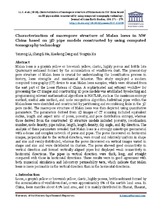| dc.description.abstract | Malan loess is a grayish yellow or brownish yellow, clastic, highly porous and brittle late Quaternary sediment formed by the accumulation of windblown dust. The present-day pore structure of Malan loess is crucial for understanding the loessification process in history, loess strengths and mechanical behavior. This study employed a modern computed tomography (CT) device to scan Malan loess samples, which were obtained from the east part of the Loess Plateau of China. A sophisticated and efficient workflow for processing the CT images and constructing 3D pore models was established by selecting and programming relevant mathematical algorithms in MATLAB, such as the maximum entropy method, medial axis method, and node recognition algorithm. Individual pipes within the Malan loess were identified and constructed by partitioning and recombining links in the 3D pore model. The macropore structure of Malan loess was then depicted using quantitative parameters. The parameters derived from 2D images of CT scanning included equivalent radius, length and aspect ratio of pores, porosity, and pore distribution entropy, whereas those derived from the constructed 3D structure models included porosity, coordination number, node density, pipe radius, length, length density, dip angle, and dip direction. The analysis of these parameters revealed that Malan loess is a strongly anisotropic geomaterial with a dense and complex network of pores and pipes. The pores discovered on horizontal images, perpendicular to the vertical direction, were round and relatively uniform in shape and size and evenly distributed, whereas the pores discovered on vertical images varied in shape and size and were distributed in clusters. The pores showed good connectivity in vertical direction and formed vertically aligned pipes but displayed weak connectivity in horizontal directions. The pipes in vertical direction were thick, long, and straight compared with those in horizontal directions. These results were in good agreement with both numerical simulation and laboratory permeability tests, which indicate that Malan loess is more permeable in the vertical direction than in the horizontal directions. | en_US |

